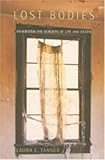Lost Bodies : Inhabiting the Borders of Life and Death / Laura E. Tanner.
Material type: TextPublisher: Ithaca, NY : Cornell University Press, [2018]Copyright date: 2006Description: 1 online resource (280 p.) : 12 halftonesContent type:
TextPublisher: Ithaca, NY : Cornell University Press, [2018]Copyright date: 2006Description: 1 online resource (280 p.) : 12 halftonesContent type: - 9781501730009
- American literature -- 20th century -- History and criticism
- Art, American -- 20th century
- Bereavement in art
- Bereavement in literature
- Death in art
- Death in literature
- Diseases in art
- Diseases in literature
- Human beings in art
- Human body in literature
- Literary Studies
- LITERARY CRITICISM / Semiotics & Theory
- 809/.9335480904 22
- online - DeGruyter
| Item type | Current library | Call number | URL | Status | Notes | Barcode | |
|---|---|---|---|---|---|---|---|
 eBook
eBook
|
Biblioteca "Angelicum" Pont. Univ. S.Tommaso d'Aquino Nuvola online | online - DeGruyter (Browse shelf(Opens below)) | Online access | Not for loan (Accesso limitato) | Accesso per gli utenti autorizzati / Access for authorized users | (dgr)9781501730009 |
Frontmatter -- Contents -- Illustrations -- Acknowledgments -- Introduction -- PART ONE: THE DYING BODY -- 1. TERMINAL ILLNESS AND THE GAZE -- 2. HAUNTED IMAGES -- 3. THE BODY IN THE WAITING ROOM -- PART TWO: THE BODY OF GRIEF -- 4. THE CONTOURS OF GRIEF AND THE LIMITS OF THE IMAGE -- 5. TEACHING THE BODY TO TALK -- 6. OBJECTS OF GRIEF -- POSTSCRIPT: LAYING THE BODY TO REST -- Notes -- Bibliography -- Index
restricted access online access with authorization star
http://purl.org/coar/access_right/c_16ec
"If the dying body makes us flinch and look away, struggling not to see what we have seen, the lost body disappears from cultural view, buried along with the sensory traces of its corporeal presence."—from the IntroductionAmerican popular culture conducts a passionate love affair with the healthy, fit, preferably beautiful body, and in recent years theories of embodiment have assumed importance in various scholarly disciplines. But what of the dying or dead body? Why do we avert our gaze, speak of it only as absence? This thoughtful and beautifully written book—illustrated with photographs by Shellburne Thurber and other remarkable images—finds a place for the dying and lost body in the material, intellectual, and imaginary spaces of contemporary American culture.Laura E. Tanner focuses her keen attention on photographs of AIDS patients and abandoned living spaces; newspaper accounts of September 11; literary works by Don DeLillo, Donald Hall, Sharon Olds, Marilynne Robinson, and others; and material objects, including the AIDS Quilt. She analyzes the way in which these representations of the body reflect current cultural assumptions, revealing how Americans read, imagine, and view the dynamics of illness and loss. The disavowal of bodily dimensions of death and grief, she asserts, deepens rather than mitigates the isolation of the dying and the bereaved. Lost Bodies will speak to anyone imperiled by the threat of loss.
Mode of access: Internet via World Wide Web.
In English.
Description based on online resource; title from PDF title page (publisher's Web site, viewed 26. Aug 2024)


